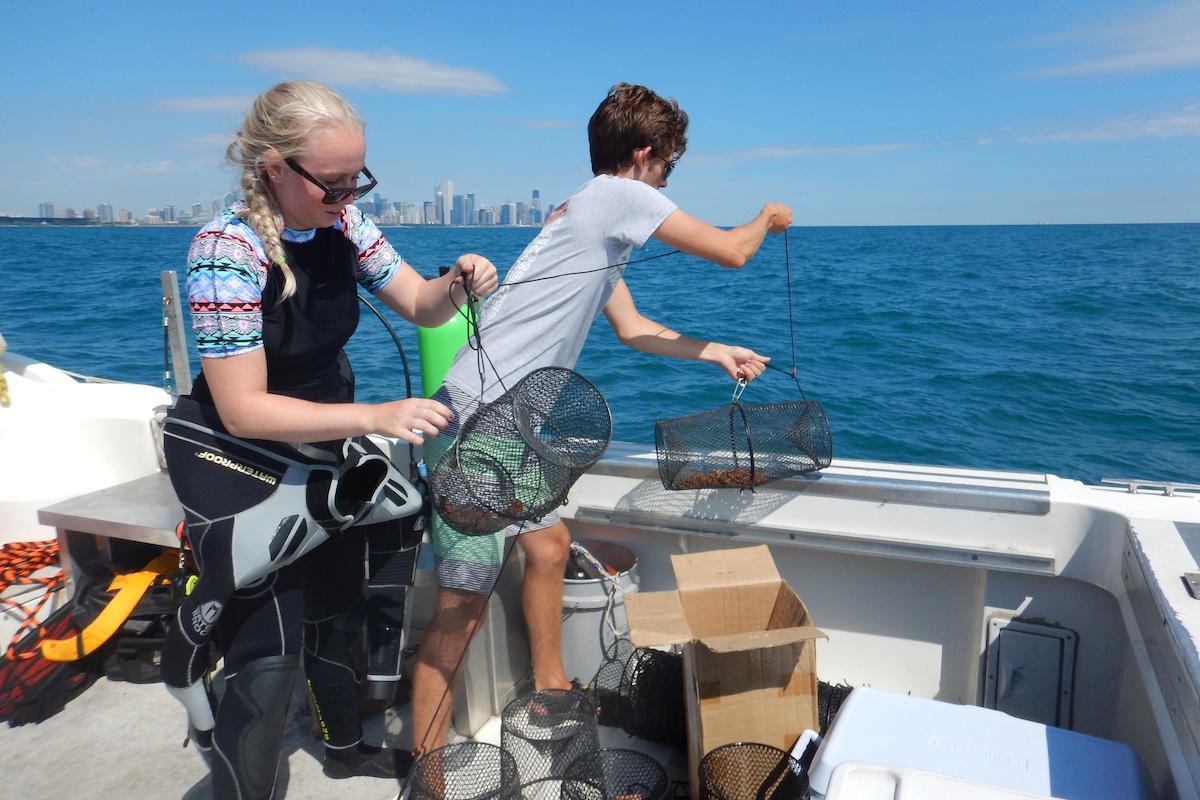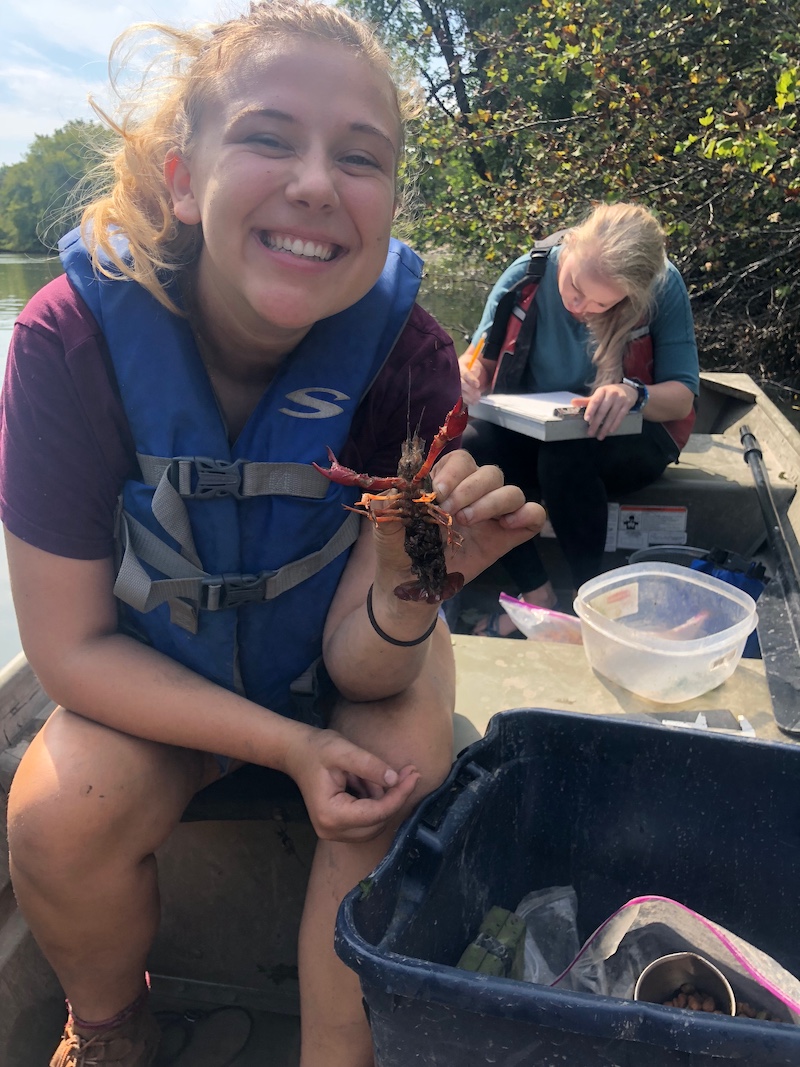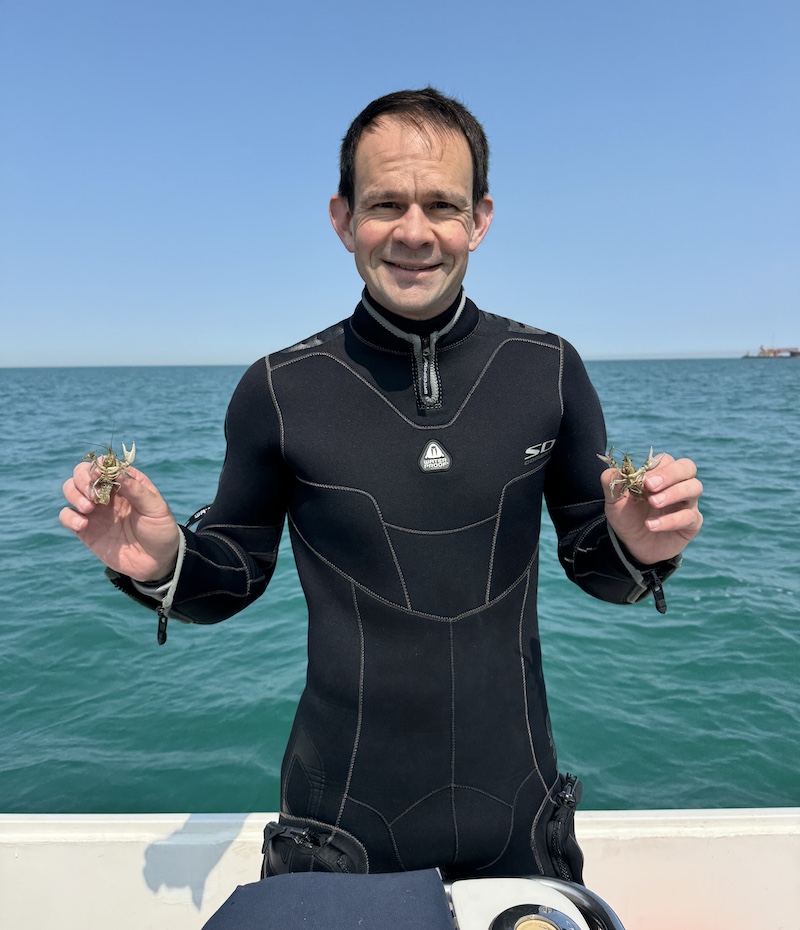
Dr. Keller’s lab also investigates crayfish populations offshore in Lake Michigan. Here, Erin O’Shaughnessy and Trent Henry are preparing to set traps about 4 miles offshore from Chicago. All photos courtesy of the author.



Dr. Keller’s lab also investigates crayfish populations offshore in Lake Michigan. Here, Erin O’Shaughnessy and Trent Henry are preparing to set traps about 4 miles offshore from Chicago. All photos courtesy of the author.
Few organisms are as important to Illinois lakes, rivers and wetlands as crayfish. Ecologists refer to them as ‘ecosystem engineers’ because of the many ways that they change and structure their habitats. For example, crayfish feeding affects the diversity of invertebrates and aquatic plants in rivers and lakes, and in wetlands they mix soil and provide habitat to other species when they dig burrows.

Crayfish are the second largest invertebrates in Illinois waterways (surpassed in size by freshwater mussels), and they eat all sorts of living and dead plants to animals. On top of this, crayfish are an important source of food for a range of fish and waterbirds, and for mammals such as river otters and raccoons. Crayfish do all of this across a remarkably broad range of Illinois habitats, from 80 feet underwater to in Lake Michigan to rivers, lakes, ponds, wetlands and prairies across the state.

The virile crayfish (Faxonius virilis) is a native species that is widespread across the state. My lab has found it 60 feet down in Lake Michigan, and we also find it in many lakes and ponds. It is only found in water and is an important consumer of plants and small invertebrates, as well as being an important food for many species of fish. In these ways it plays an important role in Illinois aquatic ecosystems.
The prairie crayfish (Procambarus gracilis) looks similar to other crayfish but lives in a very different way. This species is referred to as a ‘primary burrower,’ meaning that it digs burrows to live in. These burrows can be several feet deep and occur in prairies, wet meadows, wet forests and in seasonal wetlands. Prairie crayfish can occasionally be found in lakes and streams, but mostly they stick to the land. Like other crayfish, this species is omnivorous, meaning that it will eat a wide range of foods including decaying plants, any invertebrates that it can catch, and dead animals.
Despite their importance, we rarely see or hear much about crayfish. Why is this? The main reason is that crayfish live underground and underwater and are mostly only active at night. Being nocturnal is an important way for crayfish to avoid being eaten. Although they are large, they are quite slow-moving and they do not have good defenses against predatory fish like bass, against birds including great blue herons, or against mammals such as river otters. Instead of facing these predators when the predators can see them, crayfish spend their days resting under rocks and logs, or in their burrows. At night – when the predators can’t see as well – crayfish come out to feed.
Although Illinois has many species of crayfish, some are facing serious threats. The main threat comes from invasive crayfish species, and the most damaging of these is the rusty crayfish (Faxonius rusticus). This species became prevalent in Illinois during the 1990s and is now found across the state. It thrives in a range of habitats and in many cases we find that it has outcompeted the native species.
More recently the red swamp crayfish (Procambarus clarkii) has begun to appear. This species is native to the far southern tip of Illinois, and further south, but is now found in places across the Chicago region. It is often at low densities, but in parts of the Chicago River high populations occur and there is a major concern for further spread. My lab at Loyola University Chicago has been actively managing a population in the Chicago River for almost a decade in our efforts to prevent it from invading more waterbodies.
The other major threat to crayfish in Illinois comes from loss and degradation of habitat. Most of our wetlands have been converted to farmland and urban areas, and with them occurs a loss of habitat for a host of wildlife species, including crayfish.
Several species of Illinois crayfish also have very small ranges. For example, the bigclaw crayfish (Faxonius placidus) is known only from a very small area of southern Illinois where its limited range makes it vulnerable to any changes in habitat and water quality. For this reason, the species is listed as state endangered.

There are several actions you can take to help protect the native crayfish of Illinois.
The most important thing that we can do as individuals is to never move a crayfish from one body of water to another, and to never release crayfish. The rusty crayfish was most likely introduced by anglers who were using it as bait, and the red swamp crayfish was most likely released as an unwanted pet. Both species, and perhaps many more invasive crayfish in the future, can be spread by people moving them.
It is also important to protect aquatic and wetland habitats in Illinois. Crayfish will thrive wherever they have appropriate habitat, enough food, and good water quality. Anything we can do to improve water quality and to prevent the loss of habitat will help them.

Illinois is lucky to have many species of crayfish across its aquatic and wetland habitats. Although they can be difficult see, the effects of crayfish are always visible through the many ways that they affect our ecosystems. If you like to fish for bass, crappie and panfish, then you can appreciate crayfish because they are a main component in the diets of these fish. If you see mud chimneys in wet forest or wet meadows then there is a very good chance that there are crayfish resting in their burrows beneath your feet. We should all keep an eye out for crayfish, appreciate the ways that they benefit our ecosystems and recreation, and do what we can to protect them.
Dr Reuben Keller is a Professor in the School of Environmental Sustainability at Loyola University Chicago. He has been researching the transport, impacts, and management of invasive aquatic species in the Great Lakes for over 20 years. His favorite parts of his job are working with students and SCUBA diving in Lake Michigan.
Submit a question for the author
Question: Hi! Spotted several what I think were red swamp crawfish at Horner Park this morning.